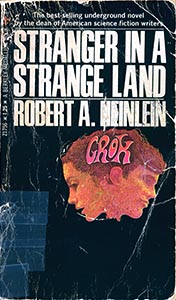I read this book about 7-Jun-2014. I've read this book before. The book is copyright 1961. This note was last modified Friday, 13-Jun-2014 20:41:29 PDT.
I've read the spots off this one less than many. It has good, and bad, and worse.
I do read it as having premonitions of the slide into total self-indulgence of his late works; this is kind of the beginning of the end. But then, probably his very best novel, The Moon is a Harsh Mistress, came significantly after this.
 This
edition has a really bizarre cover. A two-faced head (male and
female, don't look to me like they're trying to be twins, with
"grok" written in it. If nothing else, this shows that the cover
designer thought "grok" was well-known in 1972.
This
edition has a really bizarre cover. A two-faced head (male and
female, don't look to me like they're trying to be twins, with
"grok" written in it. If nothing else, this shows that the cover
designer thought "grok" was well-known in 1972.
The waterbeds in the hospital fill and drain spectacularly fast—and don't seem to be specially plumbed, either (which might otherwise explain it). They casually drain one to get a patient out of it, and then refill it. That's an actual engineering glitch which I would have expected Heinlein to catch. Also he doesn't talk about the temperature of the water, which is amazingly important in a water bed.
Jubal analyzes lots of what's wrong with America's sexual practices as coming down to jealousy, and clearly Mike's church cures people of jealousy and everyone is a lot happier. I may have internalized this; I don't do jealousy much, and certainly don't regard it as a bad thing.
Jubal shows Ben some real art, and explains it, and it makes sense as explained. But I don't find the actual pieces as moving as Jubal's descriptions. As to why these works aren't out where people can see them—well, they are. The Rodin are in a public museum. Now, there aren't reproductions allowed, so not a lot of people, and almost no Americans, get to see them. But still. And the Little Mermaid, the last of the works they study, is out in public in the Copenhagen harbor; hardly hidden or hard to access. Also frequently photographed.
Mike's church depends on learning Martian. All the real miracles are only available there. And there is no such thing as Martian. So far as we know, those miracles aren't possible. The learnings about interpersonal relationships are in another category, in some ways putting the weight on "learning Martian" devalues the human insights.
The book is wildly anti-materialist. We see activities in Heaven, with the archangels. We hear about Martian Old Ones (ghosts, souls of dead Martians). We even see Mike stick around just briefly as a ghost. Clearly that non-material world is real. This is something that has always bothered me about Heinlein; he seems to have internalized a lot of the teachings of Christianity, and then rejected just a few bits.
Jubal says "just happened" is no explanation for the universe, implying there must be conscious creation—but, then, where does the creator come from? You get at best an infinite regress, and nothing gets explained.
There are some pretty good reasons not to eat your own species, even in a modern technological society. I guess this book was written before we knew much about prions and mad cow disease, but still; it's risky at best. With another few millennia of medical progress, maybe we'll be able to say that we're all healthy enough to eat safely!